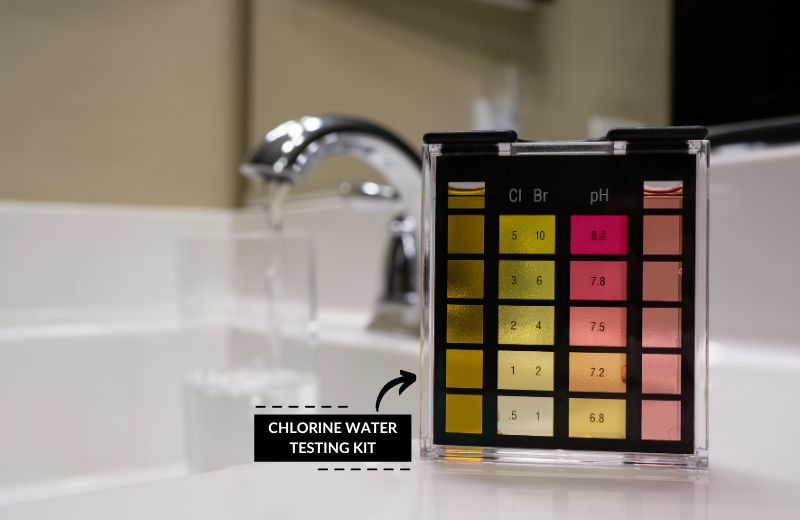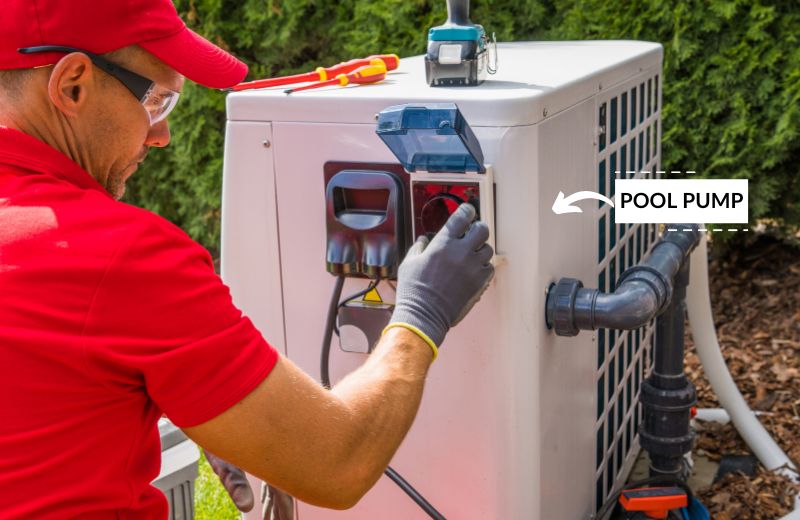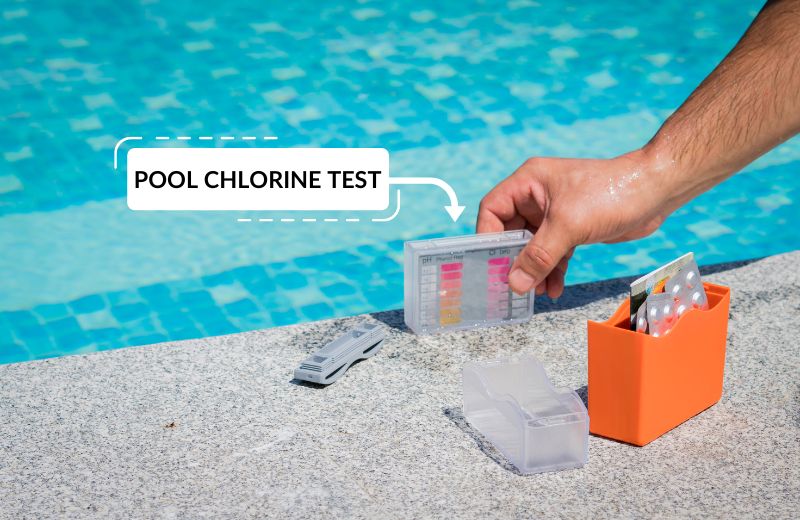Suddenly smelling chlorine bleach in your home can be slightly alarming. Luckily, most of the common reasons for sudden chlorine smells are no major cause for concern and easily resolved.
In this article, we’ve outlined the 6 likely reasons why your house might suddenly smell of chlorine – and shared our tips on what to do about it.
📌 Key Takeaways:
- The most likely causes of a chlorine smell in your house are:
- An accidental bleach spillage
- Excess chlorine in your drinking water
- The smell of toilet bowl chlorine tablets or chlorine-based dishwasher detergents
- Malfunctioning swimming pool chlorination systems
- Plumbing and electrical issues
- Smells coming from outside your home
- You can get rid of a chlorine smell in your house by addressing the cause of the smell.
- A very strong bleach smell may be caused by a chlorine gas leak, as a result of mixing chlorine with other chemicals.
Table of Contents
📈 Possible Causes of a Sudden Bleach Smell in House
Here, we’ve listed the possible causes of a chlorine odor in your home.
Accidental Bleach Spillage
The most likely cause of a sudden bleach or chlorine odor in your home is if someone accidentally spills bleach or mixes bleach with other cleaning chemicals, or if bleach spills on its own in a cupboard.

If you smell bleach in a certain location and can see visible signs of bleach (such as a puddle in your cupboard), an accidental spillage is the cause.
Excess Chlorine In Tap Water
Excess chlorine in your tap water is another cause of bleach smells in your home. If you smell chlorine when you turn on your faucet, it’s likely coming from your water.
In most cases, you should never smell chlorine in your water. Your drinking water supply should only contain trace amounts of this disinfectant.
However, you may smell bleach fumes if your municipality has detected microbiological contaminants and has temporarily increased its chlorine applications, or if you own a private well and you’ve recently shocked the well with chlorine.
👉 Eliminate chlorine with these best water filters

Toilet Bowl Cleaners Or Chlorine-Based Detergents
A mild chlorine-like odor in your home may be coming from a toilet bowl cleaner or a chlorine-based detergent.
Chlorine-based detergents are used in dishwashers to kill bacteria, sanitizing and disinfecting your dishes with every wash. Toilet bowl cleaner tablets stick to your toilet bowl and fight bacteria and unpleasant toilet odors – usually with bleach and artificial air-freshening smells.
If you can smell chlorine in the vicinity of your dishwasher or toilet, and you use any of these products, you might have found the cause of the bleach odor.
Issues With Plumbing Or Electrics Causing Bleach-Like Smell
In some cases, plumbing issues might produce a chlorine-like smell in your home.
For instance, a corroded pipe or a blocked drain could produce a chemical smell that reminds you of chlorine.

Additionally, faults in your electrical equipment could cause a sharp, biting smell that’s similar to bleach. Some brush-type motors and electric transformers produce this smell when they’re malfunctioning.
Issues With Swimming Pool Chlorination Systems
If you have a pool or a hot tub with a chlorination system, the smell of chlorine gas in your home could be caused by this system malfunctioning.
Likely, this will cause the system to release excessive quantities of pool chemicals into your pool or hot tub, releasing a chlorine odor and making the water unsafe for swimming in.
If you smell bleach in the vicinity of your pool, you might have an issue with your pool’s chlorination system.

Smell Coming From Outside Your Home
Finally, a chlorine odor in your home might actually be coming from outside your home.
For instance, your neighbor might be doing a deep clean with bleach, with their windows wide open to air the house. Or, a nearby construction site may be using a bleach-based product, and the fumes have been carried to your home in the wind.

If you smell bleach closest to your doors, vents, and windows, it’s likely coming from outside.
📋 How To Identify The Cause Of A Chlorine Smell
Here’s how to identify the chlorine gas odor in your home.
Check For Visible Spills
First, check your cleaning cupboards for visible spills. A bottle of bleach may have fallen over and leaked the liquid onto your cupboard floors.
Follow your nose, and stop to look in spots where the house smells the strongest of bleach.
Test Your Drinking Water
If you’re almost certain that the chlorine bleach scent is coming from your drinking water, conduct a chlorine water test.
Low levels of chlorine in municipal water are normal – in fact, chlorine is an essential disinfectant for killing bacteria and other microorganisms.
However, if your water’s chlorine concentration is any higher than 2.0 PPM, it’s the likely cause of the unpleasant smell – and you might be drinking dangerous levels of this chemical.

Check For Plumbing & Electrical Issues
To check that plumbing and electrical issues aren’t causing a chlorine gas smell in your home, take a look around potential problem areas. Look for blocked drains, corrosion in your plumbing, and electrical equipment that doesn’t work or looks unusual.
You might also notice an acrid smoke smell accompanying a chlorine odor with certain electrical issues.
Check Your Pool
Folks with swimming pools should check that the chlorine odor isn’t coming from the overuse of pool chemicals.
If you can smell a strong chlorine smell when standing next to your pool, check your pool’s chlorination system and take a reading of the pool chemicals in the water. This should tell you whether you have a problem.
Related: Everything you need to know about chlorine sensitivity

Step Outside
If you can’t find any cause of the chlorine odor in your home, step outside. It might not be that your house smells of bleach – the odor might actually be coming from outside.
If the chlorine odor is stronger outdoors, there’s not much you can do. Close your windows and vents until the smell goes away.
📤 How To Get Rid Of A Bleach Scent In Home
There are a few different ways to remove bleach odors from your home, depending on the cause of the smell.
Clean Up Spillages
If you’ve determined that the cause of the lingering odor is a spillage or accidental bleach mixing with other chemicals, properly clean it up and dispose of the bleach.

Make sure to ventilate the area as you clean, and wear protective gear (gloves, mask, etc.) to prevent direct contact with the bleach and to reduce your inhalation of the chemical fumes.
Service Your Pool
Too much chlorine in your pool can release chlorine gas into the air. If your pool’s chlorination system has malfunctioned, it may need to be repaired or replaced.
This job might be beyond your capabilities. Contact your local pool expert if you think you need professional support.
Call Your Plumber or Electrician
If you deduce that the cause of the pungent odor of chlorine is a plumbing or electrical issue, contact a plumber or an electrician (if necessary) to resolve the problem.
You might need to replace a part of your plumbing or clear a blocked drain. You might also need to repair or replace a faulty electrical item.
Speak To Your Local Government
If the strong odor of chlorine is coming from outside, and you think that nearby construction is to blame, contact your local government to discuss the issue.
You might also need to contact your water treatment facility if you think the chlorine odor is coming from your water supply – and you’ve tested your water and discovered unacceptably high levels of chlorine.
⛔️ A Word On Chlorine Gas Leaks
If you smell a very strong bleach odor in your home, you might be dealing with a chlorine gas leak.
Chlorine gas is formed when chlorine is mixed with other household cleaners and chemicals. You will notice a pungent chlorine gas smell.
Chlorine gas exposure is very dangerous and may cause vomiting, suffocation, coughing, shortness of breath, and chest pain.
For this reason, you should never mix bleach with any other chemicals or household cleaners containing ammonia or acids, including:
- Hydrogen peroxide
- Paints
- Vinegar
- Many glass and window cleaners
For safety, you shouldn’t even store bleach alongside any of these products.
📑 Final Word
Most causes of a sudden chlorine-like smell coming from your home are thankfully harmless. However, if you notice a very strong smell and you experience health problems like difficulty breathing or coughing, leave your home and get to fresh air as soon as possible.
When you’re away from danger, try to identify the possible cause of the smell and make a plan to resolve the issue as quickly and safely as possible.
❔ Chlorine Smell In House: FAQ
Why does my house suddenly smell like bleach?
There are several reasons why your house might suddenly smell like bleach. You might have a plumbing issue causing bleach-like fumes, your pool chlorination system might have malfunctioned, or you might have accidentally spilled bleach somewhere in your house. Or, the bleach scent could be coming from outside your house.
Does a gas leak smell like chlorine?
No, it’s unusual for a gas leak to smell like chlorine. Most gas leaks have a slightly sweet smell of sulfur or rotten eggs, whereas chlorine has a distinct chemical smell that most people associate with swimming pools. Natural gas contains a chemical called mercaptan, which is deliberately added so that a leak can easily be detected. Chlorine is NOT added to gas to give it a detectable odor.
Should I be worried if I smell bleach?
Smelling bleach in your home isn’t necessarily a cause for concern. However, you might need to be worried in some circumstances. For instance, if the bleach smell is strong and you’re struggling to breathe or experiencing other issues like dizziness, headaches, and eye irritation, you should move away from the area as soon as possible. Make sure to detect and resolve the cause of the bleach smell as soon as possible.
Why do I smell chlorine when there is none?
If you smell chlorine when there is none, the most likely cause is that there is actually bleach in the vicinity – you just don’t know it. Rarely, you might have a condition called phantosmia. This is characterized by an ability to smell odors that aren’t actually there. Ask your family members whether they can also smell bleach, and be sure to ask multiple people – some might have a sharper sense of smell than others.

